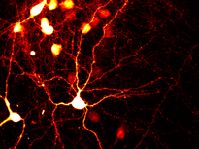Ultrafast Fiber Lasers for Time-Resolved Microscopy
Visualization of ultrafast processes on the nm scale

- Confocal microscopy
- FLIM
- Multiphoton Microscopy
- SHG Microscopy
- THG Microscopy
- CARS
- Wide tunability 488 nm - 2200 nm
- Femtosecond and picosecond pulses
- Synchronized two color beams
Modern biomedical and material research often involves advanced laser microscopy. Especially confocal laser scanning microscopy (LSM) attracts broad attention. The capability of optical sectioning and reconstruction of the sample’s 3D structure boosted the research on the single cell level, while the visualization of charge carrier dynamics in solids have completed our understandings of semiconductors.
New generation of markers for labeling of biological material
Among the newest generation of markers used for labeling of biological material are GFP and its derivates CFP, YFP, etc. In contrast to artificial dyes the GFP family is expressed inside and by the living cells themselves and attached to proteins according to the geneticist’s design. In parallel to this exciting development also the light sources for LSM kept pace. Tunable lasers account for the variety of fluorescent labels. Pulsed lasers enable fluorescent lifetime imaging microscopy (FLIM). And ultrafast lasers open the door for non-invasive methods relying on multi-photon excitation such as SHG, THG or CARS microscopy. This fs laser pulses give insight into charge carrier dynamics in solids and energy transfer in molecules as well.
Complex and bulky Ti:Sa based ultrafast laser systems tend to be too expensive for single groups. The high cost of ownership lead to the most efficient use in core facilities serving several groups. On the other hand sample preparation is very time consuming and needs extraordinary effort. A well prepared sample can not wait for measurement time in a lab that has a full schedule over weeks. Therefore femtosecond fiber lasers are the ideal solution to focus on the specific needs of many research labs. Cost-effective fiber-based laser systems with extremely low operational cost are the ideal sources of femtosecond pulses. Being ultra-reliable and 100 percent hands-off turnkey systems fiber lasers are available in a multitude of different versions for specific applications.
TOPTICA's offer
While the techniques become more advanced, the employed lasers should become easier to handle. That's why TOPTICA's fiber lasers are the product of choice. Reliable and comfortable in handling, they allow the user to focus on the scientific task. The FemtoFiber pro TVIS is a fiber coupled laser designed for confocal microscopy. It covers the entire visible range from 488 nm to 640 nm. With 40 MHz repetition rate it is perfectly suited for FLIM: In contrast to pulsed diode lasers it shows no after-ringing which can disturb the measurement. The FemtoFiber pro series allows for multi-photon and non-linear microscopy techniques: Femtosecond pulses covering wavelengths from 780 nm up to 1400 nm give access to new red markers like dTomato or two-photon excitation fluorescence (TPEF). Techniques like SHG and THG have been successfully demonstrated by our customers. Two or three synchronized and tunable outputs deliver picosecond pulses that are perfectly suited for CARS or SRS.
Even more sophisticated measurement schemes can be realized by using TOPTICA's third generation of ultrafast fiber lasers. The FemtoFiber dichro is a complete one box solution consisting of the ability to output two intrinsically synchronized fs-pulses of different colors, which can be fully controlled by an adjustable time delay and chirp (GDD-precompensation) of the pulses, individually. The FemtoFiber ultra series provides high average power of several Watts at sub-100 fs pulse durations enabling extremely high scan rates and deep penetration of the investigated sample material.
-
Related Products
-
Related Literature
- Article: Multimodale Bildgebung - Mikroskopie auf neuen Wegen
- Article: Femtosecond Lasers for Life Sciences
- Publication: Highly versatile confocal microscopy system based on a tunable femtosecond Er : fiber source
- Publication: Compact coherent anti-Stokes Raman scattering microscope based on a picoseconds two-color Er:fiber laser system
- Publication: Fiber-format CARS spectroscopy by spectral compression of femtosecond pulses from a single laser oscillator
- Publication: Fiber-format stimulated-Raman-scattering microscopy from a single laser oscillator
- Galli, R. et al. Vibrational Spectroscopic Imaging and Multiphoton Microscopy of Spinal Cord Injury. Anal. Chem. 84, 8707–8714 (2012).
- Publication: Galli, R. et al. Non-linear optical microscopy of kidney tumours. J. Biophotonics n/a–n/a (2013). doi:10.1002/jbio.2012002165.
- Publication: Krauss, G. et al. Compact coherent anti-Stokes Raman scattering microscope based on a picosecond two-color Er:fiber laser system. Opt. Lett. 34, 2847–2849 (2009).
- Publication: Galli, R. et al. Intrinsic Indicator of Photodamage during Label-Free Multiphoton Microscopy of Cells and Tissues. PLoS ONE 9, e110295 (2014).
- Publication: Jr, C.H.C., Lee, Y.J., Heddleston, J.M., Hartshorn, C.M., Walker, A.R.H., Rich, J.N., Lathia, J.D., and Cicerone, M.T. (2014). High-speed coherent Raman fingerprint imaging of biological tissues. Nat. Photonics 8, 627–634.
- Publication: Paar, M. et al. Remodeling of Lipid Droplets during Lipolysis and Growth in Adipocytes. J. Biol. Chem. 287, 11164–11173 (2012).
- Publication: Galli, R. et al. Effects of tissue fixation on coherent anti-Stokes Raman scattering images of brain. J. Biomed. Opt. 19, 071402–071402 (2013).
- Publication: Marangoni, M. et al. Fiber-format CARS spectroscopy by spectral compression of femtosecond pulses from a single laser oscillator. Opt. Lett. 34, 3262–3264 (2009).
- Publication: Galli, R. et al. CARS and non-linear microscopy imaging of brain tumors. 87970E–87970E (2013).
- Publication: Chun, W., et al. Design and demonstration of multimodal optical scanning microscopy for confocal and two-photon imaging. Rev. Sci. Instrum. 84, 013701 (2013).
- Publication: Jeong, H.-J., et al. Spectrally resolved fluorescence lifetime imaging microscope using tunable bandpass filters. Rev. Sci. Instrum. 83, 093705–093705–5 (2012).
-
Related Applications
